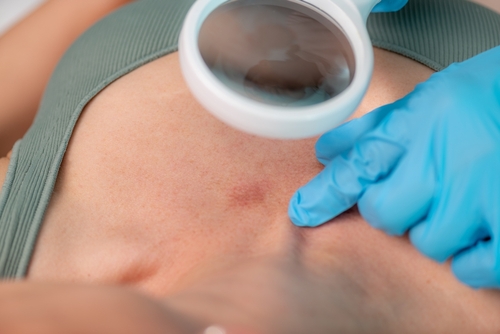The journey of diagnosing and treating skin conditions involves a nuanced and comprehensive approach that spans from initial consultations to detailed examinations by specialist dermatologists. This intricate process is crucial for the effective management of various dermatological issues, which can significantly impact a person’s quality of life. This article delves into the spectrum of practices involved in skin condition evaluation, emphasizing the roles of primary facial consultations and the advanced diagnostic methods employed by specialist doctors.
Understanding Basic Skin Types: Dry, Oily, and Combination
Before diving into specialized diagnostic procedures, it’s essential to assess the basic skin types—dry, oily, and combination—as they often influence the development and treatment of more complex skin conditions.
- Dry skin, characterized by a lack of moisture and possibly flakiness, can be more susceptible to irritation and eczema.
- Oily skin, marked by excessive sebum production, often leads to enlarged pores and acne.
- Combination skin features regions of both dry and oily characteristics, typically with oiliness in the T-zone (forehead, nose, and chin) and dryness on the cheeks.
Practitioners recommend specific cleansers, moisturizers, and treatments that align with the skin type to restore balance and prevent common problems like acne or dermatitis. You can look into a free skincare consultation at mgskincare.co.uk to start getting to grips you’re your skin. Additionally, understanding these basic types provides a foundation for identifying underlying issues that may require more targeted interventions.
Initial Consultation and Facial Analysis
The first step in the diagnosis of a skin condition typically begins with a facial consultation. During this initial encounter, healthcare professionals utilize a holistic approach to assess the patient’s skin. This assessment is not merely about looking at the skin, but also understanding the patient’s medical history, lifestyle, and any previous treatments they have received. Dermatologists, or sometimes trained aestheticians, examine the skin using both visual and tactile inspections to identify any abnormalities such as rashes, discoloration, or unusual lesions.

A crucial component of the facial consultation is the use of non-invasive imaging technologies. Tools like dermoscopy or digital skin imaging allow practitioners to observe the epidermal and dermal layers of the skin more closely. These technologies can help in identifying early signs of conditions such as melanoma, acne, eczema, or psoriasis, which might not be fully apparent to the naked eye.
Advanced Diagnostic Techniques
Following the initial assessment, if further investigation is needed, advanced diagnostic techniques come into play. These methods are essential, especially when dealing with complex skin conditions that require a detailed understanding to formulate an effective treatment plan. Some of the advanced practices include:
- Biopsy and Histopathology: A skin biopsy might be performed where a small sample of skin is removed for microscopic examination. This is critical in diagnosing conditions like skin cancer or inflammatory skin diseases. Histopathological analysis helps in understanding the cellular makeup and behavior of skin lesions.
- Patch Testing: Used primarily to diagnose skin allergies, patch testing involves applying patches with different allergens to the skin. This test helps identify specific substances that a person’s skin may react to, thus pinpointing potential allergens causing dermatitis or other skin reactions.
- Genetic Testing: Some skin conditions are influenced by genetic factors. Genetic testing can be crucial in diagnosing hereditary skin diseases, providing information that guides more personalized treatment options.
Specialist Consultations and Multidisciplinary Approach
Often, the evaluation of skin conditions does not stop at dermatology. It involves a multidisciplinary approach where dermatologists may collaborate with allergists, immunologists, oncologists, and even genetic counselors to provide comprehensive care. This collaboration is particularly important in complex cases where the skin condition might be a symptom of a more systemic issue.

Specialist dermatologists play a pivotal role in this advanced phase of diagnosis. They perform the necessary diagnostic tests and interpret the results to develop a tailored treatment plan. Depending on the individual’s specific needs, this plan may include pharmacological treatments, therapeutic procedures, or lifestyle adjustments.
Conclusion
Evaluating skin conditions is a layered process that requires expertise from basic understanding of skin types to sophisticated, specialist-driven diagnostics. Each step in this continuum is vital, ensuring that patients receive a precise diagnosis and the most effective treatment. Through such thorough evaluations, healthcare professionals can significantly improve the management of dermatological diseases, enhancing patient outcomes and quality of life.
Doctor Reveals: 10 Surprising Habits That Are Secretly Making You Age Faster





